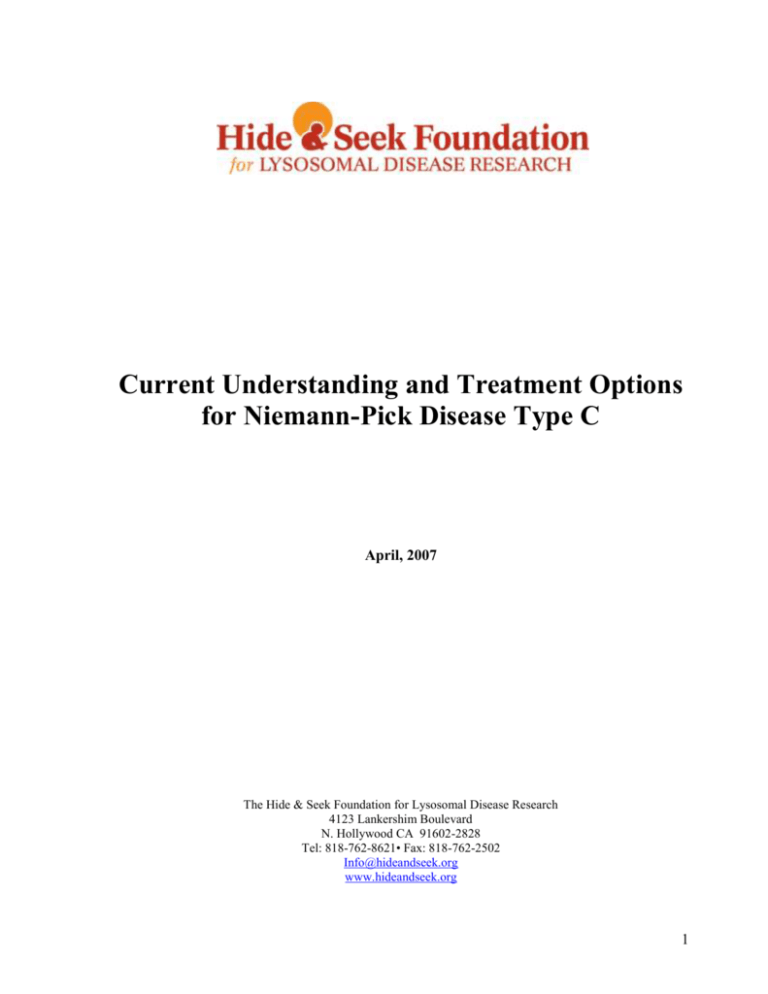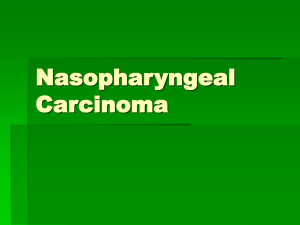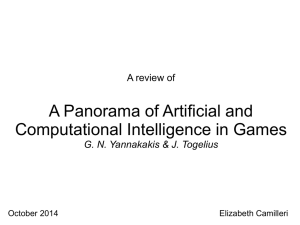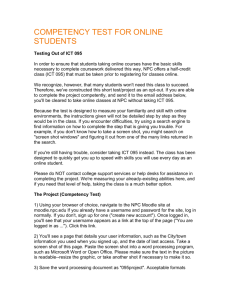npc-white-paper-4-2007
advertisement

Current Understanding and Treatment Options for Niemann-Pick Disease Type C April, 2007 The Hide & Seek Foundation for Lysosomal Disease Research 4123 Lankershim Boulevard N. Hollywood CA 91602-2828 Tel: 818-762-8621• Fax: 818-762-2502 Info@hideandseek.org www.hideandseek.org 1 What we currently know about Niemann-Pick C disease Niemann-Pick type C disease (NPC) is a neurovisceral lipid storage disorder originally grouped with Niemann-Pick types A and B (NPA and NPB) in 1958 on the basis of clinical symptoms and biochemical features. In 1966, Niemann-Pick types A and B were identified as inherited deficiencies of lysosomal acid sphingomyelinase. The biochemical and molecular bases of NPC disease remained uncertain for many years since variable impairment of acid sphingomyelinase was found in different tissues. The discovery of defects in esterification of cholesterol in fibroblasts from NPC patients by Pentchev and colleagues in the early 1980’s and the power of this observation as a diagnostic tool led to the view that NPC disease was primarily a cholesterol storage disease, further differentiating NPC from NPA and B in which sphingomyelin was the primary storage material. In addition to storage of unesterified cholesterol, NPC was also documented to exhibit massive storage of another class of compounds known as glycosphingolipids (GSLs), including gangliosides. Neurons in NPC are known to accumulate cholesterol and GSLs over long periods of time with some cell types appearing more vulnerable than others. Cerebellar Purkinje cells are particularly sensitive to the disease and die early in most cases of NPC disease leading to motor system abnormalities. Other brain lesions include microglial activation and related inflammatory events, ectopic dendritogenesis, axonal spheroid formation, and neurofibrillary tangle formation. The latter feature is also a hallmark of Alzheimer’s disease, and why this occurs in NPC and other secondary tauopathies is unknown. In 1997 the defective gene and protein responsible for the majority (~95%) of cases of NPC disease was identified. Named NPC1, the protein consists of 1278 amino acids and exhibits 13-16 membrane spanning domains. NPC1 shows high homology with Patched, a critical element in sonic hedgehog signaling pathway, as well as with proteins involved in cholesterol homeostasis, including 3-hydroxy-3-methylglutaryl coenzyme A (HMG-CoA) reductase and with SCAP, the sterol regulatory elementbinding protein (SREBP)-cleavage-activating protein (SCAP). NPC1 was believed localized to membranes of vesicles known as late endosomes. It was subsequently discovered that defects in another protein (NPC2) are responsible for the remaining 5% of cases of NPC disease. NPC2 is a 151 amino acid soluble protein of late endosomes and lysosomes that has been shown to bind unesterified cholesterol. Deficiencies of NPC1 and NPC2 proteins appear to cause essentially identical diseases in both humans and in mouse models of NPC disease. Both NPC1 and NPC2 genes are highly conserved in evolution and are found, for example, in the simplest of eukaryotic organisms, yeast. For NPC1, a homologous gene may also exist in prokaryotic organisms (bacteria), further emphasizing its role in a 2 critically important “housekeeping” function in the cell. Numerous experimental models of NPC1 deficiency exist or are being developed, including in yeast, nematodes, fruit flies, mice and cats. The larger mammalian models are particularly advantageous in terms of more accurately replicating the human disease and offering a means to test therapeutic efficacy. The state of current research The major sources of funding for NPC research are the National Institutes of Health (NIH) and the Ara Parseghian Medical Research Foundation (APMRF). The National Niemann-Pick Disease Foundation (NNPDF) and a few family-based foundations also make smaller grants for NPC research. In 2006, total direct cost of funding provided by the NIH, APMRF and others was between $3,500,000 and $4,000,000. Basic science research today is focusing on: o Molecular modeling and function of the NPC1 and NPC2 proteins; o Mechanisms by which NPC1 and NPC2 proteins may interact; o Specific impact of NPC1/NPC2 deficiencies on neuron viability; o The relationship between the two major storage products in NPC disease – cholesterol and glycosphingolipids relative to the function of NPC1 and NPC2 proteins; o Developing additional models of NP-C in simple organisms (yeast, fly, flat worm) and in mice where detailed knowledge of the defect can be gained through genetic modulation. Translational research oriented toward developing treatments for NPC is focusing on: o Delineating mechanisms whereby single injections of allopregnanolone in early life can double longevity in the NPC1 mouse; o Determining means to stimulate cells to overcome their NPC1/NPC2 deficiency by altered intracellular trafficking; o Determining whether anti-inflammatory, anti-apoptotic, or anti-oxidative agents can be significantly neuroprotective; o Developing vectors for gene replacement therapy; o High throughput screening of drugs that can alter the NPC disease cellular phenotype; o Determining the synergistic nature of combination therapies using mouse models; o Determining authentic biomarkers for disease progression in large animal models and patients; A longitudinal observational study was initiated at the National institutes of health in 2006. This clinical protocol is designed to evaluate clinical and biochemical markers of of Niemann-Pick disease, type C. The goal of this protocol is to identify potential outcome measures that could be used in a subsequent clinical trial. Serum, cerebral spinal fluid, and urine specimens are being collected for analysis. Clinical evaluation includes audiologic (including auditory brainstem responses), psychological, and 3 neurological evaluation. Magnetic resonance spectroscopy and diffusion tensor imaging are being preformed on a 3 Tesla instrument. Seventeen patients have been enrolled into this observational study. Current research efforts are directed at (1) understanding the biology of the NPC1 and NPC2 proteins, and (2) translating basic research into new therapies for NPC disease. While treatment options at present are limited to substrate reduction therapy (i.e. miglustat), which reduces glycosphingolipids (GSL) synthesis, a number of emerging therapies are being examined in animal models of NPC disease. Current treatment strategies The current state of treatment options for NPC disease is presented below. Therapeutic approaches are classified as Available (in clinical use), Emerging (less than three years from clinical evaluation) or Developing (greater than three years from clinical evaluation). Available treatment options: Substrate Reduction Therapy (SRT). This treatment concept centers on the use of inhibitors of GSL synthesis to slow the accumulation of materials in brain cells. Similar to the use of so-called statin drugs to reduce high cholesterol, the rationale is that reducing the synthesis of one of the major classes on storage compounds in brain cells (in this case GSLs, or more specifically, gangliosides) might allow these cells to function normally for a longer period of time (and thereby delay onset of clinical disease). One such compound is miglustat, which is marketed by Actelion as Zavesca; Genzyme is in Stage 2 development of a similar compound. Miglustat has been approved for use in two other lysosomal storage diseases, Gaucher disease and Fabry disease. It has shown modest benefits in some patients with advanced Niemann-Pick C in a clinical trial now underway. Recent studies in NPC mice have also shown significant synergy in terms of survival when miglustat was combined with early treatment of allopregnanolone, a naturally-occurring brain steroid (described below). Emerging treatment options: Byproduct Replacement Therapy (BRT). This treatment approach emerged from research over the past several years that has indicated (1) the brains of NPC mice are deficient in the naturally-occurring brain steroid known as allopregnanolone, and (2) injection of this compound in the early postnatal period has the ability to limit lysosomal storage and thus prolong survival. It is not known if such neurosteroid deficiencies are present in feline or human NPC. While the mechanism by which allopregnanolone works is not fully understood, recent findings suggest a critical role for its ability to act as a activator for the nuclear receptor known as the pregnane X receptor (PXR) and thereby exert control over numerous genes, possibly including those controlling cholesterol availability in cells. If these studies are borne out, consideration should be given to testing existing drugs that cross into the CNS and have been documented to activate nuclear receptors like PXR. Candidate compounds include 4 ganaxolone (a synthetic variant of allopregnanolone available through Marinus Pharmaceuticals), T0901317, DHEA, dexamethasone, hyperforin (an ingredient of St John’s Wort), and a host of related compounds. Anti-inflammatory Agents. The use of aspirin or NSAIDs (nonsteroidal antiinflammatory drugs), or other more potent anti-inflammatory drugs may be useful to diminish inflammation in brain and other organs and thereby reduce early cell death, including neuronal cell death. Such treatment would not be expected to stop the underlying disease process, but might, as described above, be useful to ameliorate disease progression in combination with other treatment approaches. This approach has shown survival benefit in a mouse model of Sandhoff disease, another neurodegenerative lysosomal disease. Anti-oxidant Agents have been given by parents to a number of NPC patients. These include Chinese herbs, CoQ10, DMSO and other supplements. DMSO was included amongst agents in the first randomized clinical trial in NPC, and has no apparent effect clinically or on cholesterol levels in the liver. An unpublished study of vitamin E in the NPC mouse (Pentchev and Patterson) beginning in utero showed no benefit. It is not known whether antioxidant therapy could slow the progression of NPC, but it has been shown to provide some level of protection in the mouse model of Sandhoff disease. Developing treatment options: Rab Protein Therapy. Rab proteins (technically known as small GTPases) regulate movement of cargo within cells. Increased levels of Rab proteins known as Rab 9 and Rab 7 in NPC cells in culture have been shown to correct the cellular phenotype, including clearance of accumulated cholesterol from the endosomal-lysosomal system. Ongoing studies examining genetic means to increase the levels of Rab proteins in mice have produced modestly promising but inconclusive results. The hope is that correcting membrane traffic in NPC cells by modulating the levels of Rab proteins will make it possible to bypass the deleterious effects of the defective NPC protein in humans. Two researchers are investigating this approach, with at least one of them utilizing high throughput screening to identify potential pharmacological compounds that could influence Rab levels. Cell-mediated Therapies. These approaches, which include stem cell and bone marrow transplantation (BMT) therapy, have also been tested in multiple lysosomal disorders. BMT has proven remarkably effective in ameliorating storage, even in the brain, in a small number of lysosomal diseases (e.g., one known as alpha-mannosidosis). A critical aspect of this therapy is known as cross-correction, whereby normal cells can metabolically correct diseased cells by passing the missing protein to them. However, NPC1, the defective protein in the most common form of NPC disease, is a nonsecreted transmembrane protein of late endosomes and it cannot be expected to be transferred between cells. Nevertheless, while not protective by itself, it is possible that BMT could indirectly be useful as part of a combination therapy with other approaches 5 to therapy by acting to reduce inflammation. Reports of BMT and hepatic transplantation in human NPC have shown no evidence of neurological benefit. Anti-apoptotic Agents. Apoptosis (cell-death) takes place at a late stage of NPC and is a very downstream disease event. There is research underway that is directed at reversing apoptosis in NPC mice. However, there is concern that anti-apoptotic agents might be harmful because normal programmed cell death, with which they would conceivably interfere, is presumably important for general health. On the other hand, it may be that an apoptotic drug, if safe, could be a useful add-on to other therapies. Chemical Chaperone Therapy. This new treatment concept is based on the hypothesis that many NPC mutations cause disease because the mutant protein is unable to mature from the endoplasmic reticulum and is thus unable to be targeted to the late endosome. Pharmacologically relevant chemical chaperones have shown great promise recently in enhancing mutant protein maturation in other genetic diseases and thus partially rescuing protein function. A few small molecule chaperones have already been identified, which represents a critical step towards developing an actual drug that literally chaperones proteins to their appropriate target, thereby potentially correcting the NPC disease phenotype. Gene Therapy. The possible use of gene therapy for treatment of lysosomal disorders is under intensive investigation for some lysosomal disorders, although there are significant central nervous system (CNS)-delivery and safety issues to be resolved. Furthermore, the problem of NPC1 as a non-secreted transmembrane protein remains. Thus, widespread cell transduction would be necessary because neurons and other cells throughout the brain will need to receive the gene in order to be rescued, a difficult outcome to achieve without innovative advances in gene delivery technology. Cholesterol-Lowering Drugs. The discovery that cholesterol accumulated in NPC cells was once believed to suggest that cholesterol-lowering agents might be therapeutic. However, cholesterol in the brain is nearly all synthesized in the CNS, thus, lowering cholesterol elsewhere in the body would probably have little effect on cholesterol in neurons. More important, there is emerging evidence that points to cholesterol accumulation in NPC-affected cells as a cause of deficiency of certain byproducts of cholesterol metabolism, like allopregnanolone (see above). The first randomized clinical trial in NPC examined the effects of cholesterol-lowering strategies in NPC. Although unesterified cholesterol (i.e. cholesterol not attached to fatty acids) was substantially reduced in the liver by combination therapy, subsequent follow up showed no evidence of clinical benefit There is widespread consensus in the lysosomal disease field that the next few years will see an emphasis of combination therapies in the treatment of these disorders. For NPC disease, while no single therapy on its own may be corrective, combining treatment approaches could be beneficial. For example, treatment in the mouse model of NPC disease that combines miglustat therapy with allopregnanolone, a naturally-occurring brain steroid (see BRT above), extends life span by 2.5 times, the longest reported for this model to date. 6 Some of the major questions about NPC disease that remain unanswered: Basic science issues – What are the exact function(s) of NPC1 and NPC2 proteins? Do these two proteins function together as part of a single mechanism? What is the relationship between the function of these proteins and the accumulation of unesterified cholesterol and GSLs? What are the key pathological steps set in motion by absence of NPC proteins? Why are some neurons highly vulnerable to NPC1/NPC2 deficiency, whereas others are not? How does allopregnanolone extend lifespan of NPC mice? Is the action through PXR or related nuclear receptors? Are allopregnanolone and other neurosteroids deficient in feline and human NPC, or is this deficiency unique to NPC mice? Given the marked phenotypic variability seen amongst individuals in multiplex NPC kindreds, what epigenetic factors or modifier genes interact with NPC1 and NPC2? Translational science issues – What are the relative roles of overabundance of storage compounds or deficiency of sequestered compounds and/or their byproducts in producing brain disease in NPC? What disease markers correlate with the clinical phenotype and could be used to follow disease progression in clinical trials and permit accurate prognostication? How can NPC be identified early? The current diagnostic tests are cumbersome, and can only be performed in a few laboratories. How do drugs like miglustat effect gene expression? Could a molecular genetic analysis provide such information? 7






